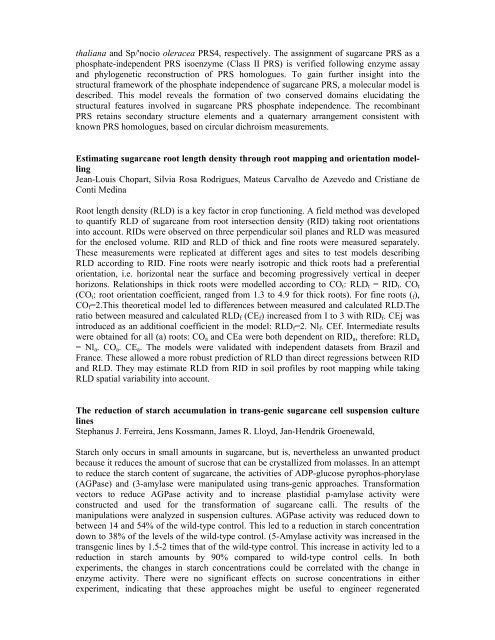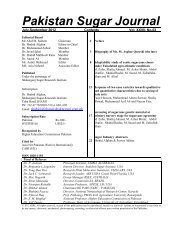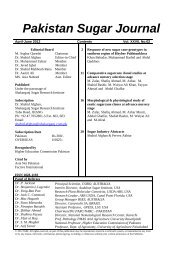Pakistan Sugar Journal
April-June 2010 - Shakarganj Group
April-June 2010 - Shakarganj Group
You also want an ePaper? Increase the reach of your titles
YUMPU automatically turns print PDFs into web optimized ePapers that Google loves.
thaliana and Sp/'nocio oleracea PRS4, respectively. The assignment of sugarcane PRS as a<br />
phosphate-independent PRS isoenzyme (Class II PRS) is verified following enzyme assay<br />
and phylogenetic reconstruction of PRS homologues. To gain further insight into the<br />
structural framework of the phosphate independence of sugarcane PRS, a molecular model is<br />
described. This model reveals the formation of two conserved domains elucidating the<br />
structural features involved in sugarcane PRS phosphate independence. The recombinant<br />
PRS retains secondary structure elements and a quaternary arrangement consistent with<br />
known PRS homologues, based on circular dichroism measurements.<br />
Estimating sugarcane root length density through root mapping and orientation modelling<br />
Jean-Louis Chopart, Silvia Rosa Rodrigues, Mateus Carvalho de Azevedo and Cristiane de<br />
Conti Medina<br />
Root length density (RLD) is a key factor in crop functioning. A field method was developed<br />
to quantify RLD of sugarcane from root intersection density (RID) taking root orientations<br />
into account. RIDs were observed on three perpendicular soil planes and RLD was measured<br />
for the enclosed volume. RID and RLD of thick and fine roots were measured separately.<br />
These measurements were replicated at different ages and sites to test models describing<br />
RLD according to RID. Fine roots were nearly isotropic and thick roots had a preferential<br />
orientation, i.e. horizontal near the surface and becoming progressively vertical in deeper<br />
horizons. Relationships in thick roots were modelled according to CO t : RLD t = RID t . CO t<br />
(CO t : root orientation coefficient, ranged from 1.3 to 4.9 for thick roots). For fine roots ( f ),<br />
CO f =2.This theoretical model led to differences between measured and calculated RLD.The<br />
ratio between measured and calculated RLD f (CE f ) increased from I to 3 with RID f . CEj was<br />
introduced as an additional coefficient in the model: RLD f =2. Nl f . CEf. Intermediate results<br />
were obtained for all (a) roots: CO a and CEa were both dependent on RID a , therefore: RLD a<br />
= Nl a . CO a . CE a . The models were validated with independent datasets from Brazil and<br />
France. These allowed a more robust prediction of RLD than direct regressions between RID<br />
and RLD. They may estimate RLD from RID in soil profiles by root mapping while taking<br />
RLD spatial variability into account.<br />
The reduction of starch accumulation in trans-genic sugarcane cell suspension culture<br />
lines<br />
Stephanus J. Ferreira, Jens Kossmann, James R. Lloyd, Jan-Hendrik Groenewald,<br />
Starch only occurs in small amounts in sugarcane, but is, nevertheless an unwanted product<br />
because it reduces the amount of sucrose that can be crystallized from molasses. In an attempt<br />
to reduce the starch content of sugarcane, the activities of ADP-glucose pyrophos-phorylase<br />
(AGPase) and (3-amylase were manipulated using trans-genic approaches. Transformation<br />
vectors to reduce AGPase activity and to increase plastidial p-amylase activity were<br />
constructed and used for the transformation of sugarcane calli. The results of the<br />
manipulations were analyzed in suspension cultures. AGPase activity was reduced down to<br />
between 14 and 54% of the wild-type control. This led to a reduction in starch concentration<br />
down to 38% of the levels of the wild-type control. (5-Amylase activity was increased in the<br />
transgenic lines by 1.5-2 times that of the wild-type control. This increase in activity led to a<br />
reduction in starch amounts by 90% compared to wild-type control cells. In both<br />
experiments, the changes in starch concentrations could be correlated with the change in<br />
enzyme activity. There were no significant effects on sucrose concentrations in either<br />
experiment, indicating that these approaches might be useful to engineer regenerated






